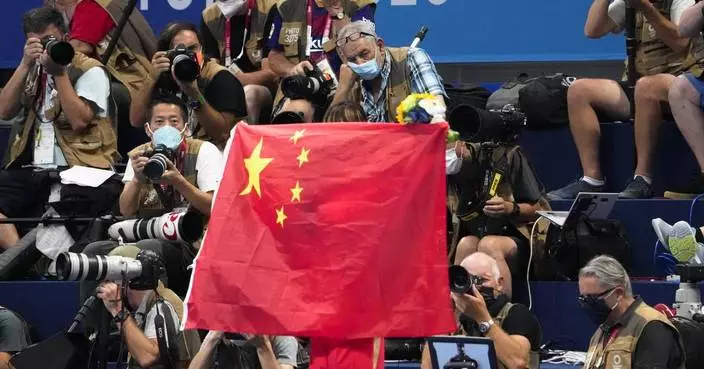Thirteen Japanese cult members may be sent to the gallows any day now for a deadly 1995 gas attack on the Tokyo subway system and other crimes. But when is uncertain. Such is the secrecy that surrounds Japan's death penalty system.
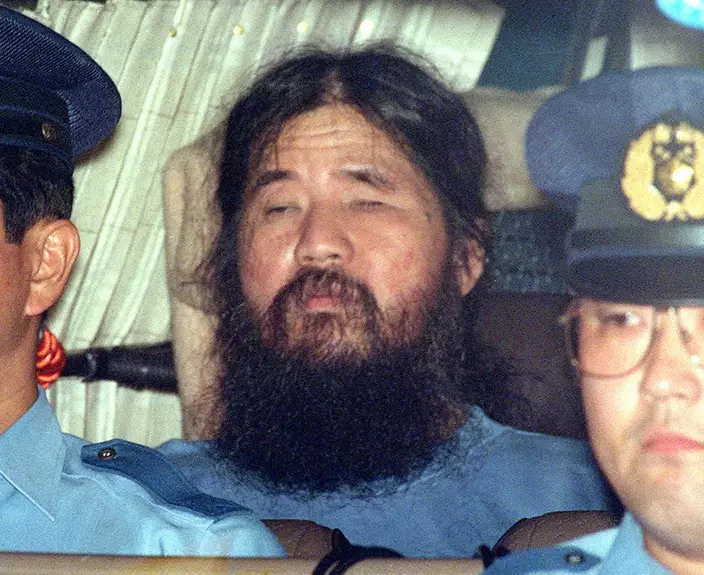
FILE - In this Sept. 25, 1995, file photo, cult leader Shoko Asahara, center, sits in a police van following an interrogation in Tokyo. Thirteen Japanese cult members may be sent to the gallows any day now for a deadly 1995 gas attack on the Tokyo subway system and other crimes. . (Kyodo News via AP, File)

FILE - In this undated file photo, cult guru Shoko Asahara, left, of Aum Shinrikyo walks with Yoshihiro Inoue, then a close aid, in Tokyo. (Kyodo News via AP, File)
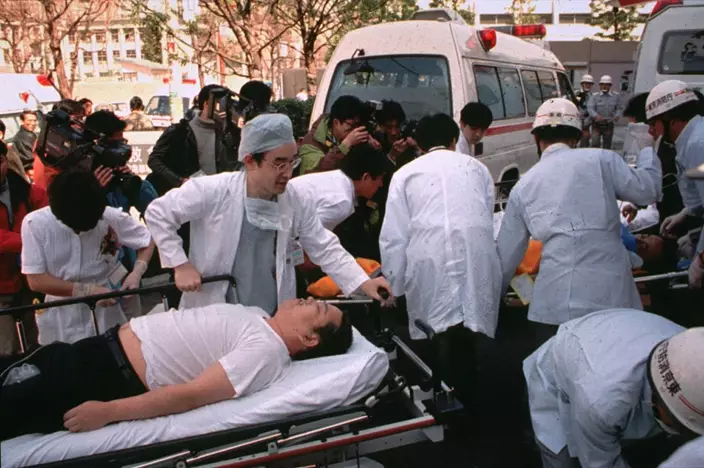
FILE - In this March 20, 1995 file photo, subway passengers affected by sarin nerve gas in the central Tokyo subway trains are carried into St. Luke's International Hospital in Tokyo. (AP Photo/Chiaki Tsukumo, File)

FILE - In this May 9, 1995 file photo, two woman devotees to the doomsday cult, Aum Shinrikyo, watch a group of police search their building in Fujinomiya, central Japan. (AP Photo/Sadayuki Mikami, File)
Tuesday marks 23 years since members of the Aum Shinrikyo cult punctured plastic bags to release sarin nerve gas inside subway cars, sickening thousands and killing 13. Cult leader Shoko Asahara and a dozen followers have been sentenced to death for that and other crimes that killed 27 in all.
Click to Gallery
Thirteen Japanese cult members may be sent to the gallows any day now for a deadly 1995 gas attack on the Tokyo subway system and other crimes. But when is uncertain. Such is the secrecy that surrounds Japan's death penalty system.
FILE - In this undated file photo, cult guru Shoko Asahara, left, of Aum Shinrikyo walks with Yoshihiro Inoue, then a close aid, in Tokyo. (Kyodo News via AP, File)
FILE - In this March 20, 1995 file photo, subway passengers affected by sarin nerve gas in the central Tokyo subway trains are carried into St. Luke's International Hospital in Tokyo. (AP Photo/Chiaki Tsukumo, File)
FILE - In this May 9, 1995 file photo, two woman devotees to the doomsday cult, Aum Shinrikyo, watch a group of police search their building in Fujinomiya, central Japan. (AP Photo/Sadayuki Mikami, File)
Tuesday marks 23 years since members of the Aum Shinrikyo cult punctured plastic bags to release sarin nerve gas inside subway cars, sickening thousands and killing 13. Cult leader Shoko Asahara and a dozen followers have been sentenced to death for that and other crimes that killed 27 in all.
The Jan. 7, 1990 photo shows Tomomitsu Niimi, a member of Aum Shinrikyo doomsday cult who has been sentenced to death. Tuesday, March 20, 2018 marks 23 years since members of the Aum Shinrikyo cult punctured plastic bags to release sarin nerve gas inside subway cars, sickening thousands and killing 13. Cult leader Shoko Asahara and a dozen followers have been sentenced to death for that and other crimes that killed 27 in all. (Kyodo News via AP)
FILE - In this March 25, 1995, file photo, Aum Shinrikyo members look out from a window to observe the fourth-day of a police raid operation at No. 6 Satian, one of the doomsday cult's communes near Mount Fuji in Kamikuishiki, west of Tokyo. (AP Photo/Hiroshi Otabe, File)
FILE - This 1990 file photo shows former member of Aum Shinrikyo doomsday cult Kazuaki Okazaki who has been sentenced to death. Tuesday, March 20, 2018 marks 23 years since members of the Aum Shinrikyo cult punctured plastic bags to release sarin nerve gas inside subway cars, sickening thousands and killing 13. (Kyodo News via AP, File)
FILE - This undated file photo shows A former Aum Shinrikyo cult member Masato Yokoyama who was sentenced to death in 1999. Thirteen Japanese cult members may be sent to the gallows any day now for a deadly 1995 gas attack on the Tokyo subway system and other crimes. (AP Photo/Kyodo News)
The relocation of seven of them to five detention centers outside of Tokyo last week has sparked speculation that executions could be imminent. In Japan, accomplices in a crime are customarily hanged on the same day. Ten of those on death row were convicted for the subway attack, a number beyond the Tokyo detention center's daily capacity.
This March 15, 2018 photo, shows the Tokyo Detention Center in Tokyo. Thirteen Japanese cult members may be sent to the gallows any day now for a deadly 1995 gas attack on the Tokyo subway system and other crimes. (AP Photo/Shizuo Kambayashi)
In this March 15, 2018 photo, people walk near the Tokyo Detention Center in Tokyo. Thirteen Japanese cult members may be sent to the gallows any day now for a deadly 1995 gas attack on the Tokyo subway system and other crimes. (AP Photo/Shizuo Kambayashi)
FILE - This Aug. 27, 2010 file shows the main gallows of the Tokyo Detention Center in Tokyo. Thirteen Japanese cult members may be sent to the gallows any day now for a deadly 1995 gas attack on the Tokyo subway system and other crimes. (Kyodo News via AP, File)
FILE - In this Aug. 27, 2010, file photo, multiple push buttons for executioners to activate a trapdoor are seen on the wall of a room adjacent to the main execution chamber with a ceiling-mounted pulley and the trapdoor marked with red squares on the floor at the Tokyo Detention Center in Tokyo. (Kyodo News via AP, File)
Her wish is unlikely to be granted.
Subway staff members offer a silent prayer at a station in Tokyo Tuesday, March 20, 2018, to mark the 23rd anniversary of sarin nerve gas attack by the Aum Shinrikyo cult. Members of the Aum Shinrikyo cult punctured plastic bags to release sarin nerve gas inside subway cars in 1995, sickening thousands and killing 13. (Yoshitaka Sugawara/Kyodo News via AP)
Toyohiko Otomo, head of the Kasumigaseki subway station district, offers flowers at Kasumigaseki station in Tokyo Tuesday, March 20, 2018, to mark the 23rd anniversary of sarin nerve gas attack by the Aum Shinrikyo cult. Members of the Aum Shinrikyo cult punctured plastic bags to release sarin nerve gas inside subway cars in 1995, sickening thousands and killing 13. (Yoshitaka Sugawara/Kyodo News via AP)
Some survivors of the cult's crimes oppose the executions because that would eliminate hopes for a fuller explanation of the crimes.
Shizue Takahashi, the wife of a subway worker killed in the March 20, 1995 sarin gas attack, prays after laying flowers on the stand set up at Kasumigaseki subway station in Tokyo Tuesday, March 20, 2018, to mark the 23rd anniversary of sarin nerve gas attack by the Aum Shinrikyo cult. (Yoshitaka Sugawara/Kyodo News via AP)
At 8 a.m. Tuesday, around the time of the attack, uniformed subway employees lowered their heads in silence at Kasumigaseki station, a main target of the cult. Shizue Takahashi, the 71-year-old widow of an assistant stationmaster who died in the attack, and the current station master, placed flowers on a temporary altar set up for offerings.
"It seems the (legal) process has entered a next stage," Takahashi told reporters. "I hope (executions) are carried out in accordance with the law."
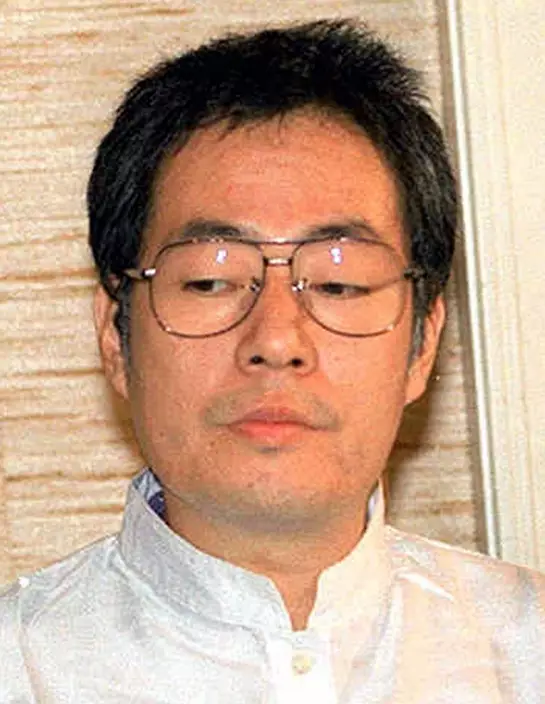
FILE- This undated file photo, shows former senior Aum Shinrikyo member Kiyohide Hayakawa who was sentenced to death in 2000. Tuesday, March 20, 2018 marks 23 years since members of the Aum Shinrikyo cult punctured plastic bags to release sarin nerve gas inside subway cars, sickening thousands and killing 13. Cult leader Shoko Asahara and a dozen followers have been sentenced to death for that and other crimes that killed 27 in all. (Kyodo News via AP, File)
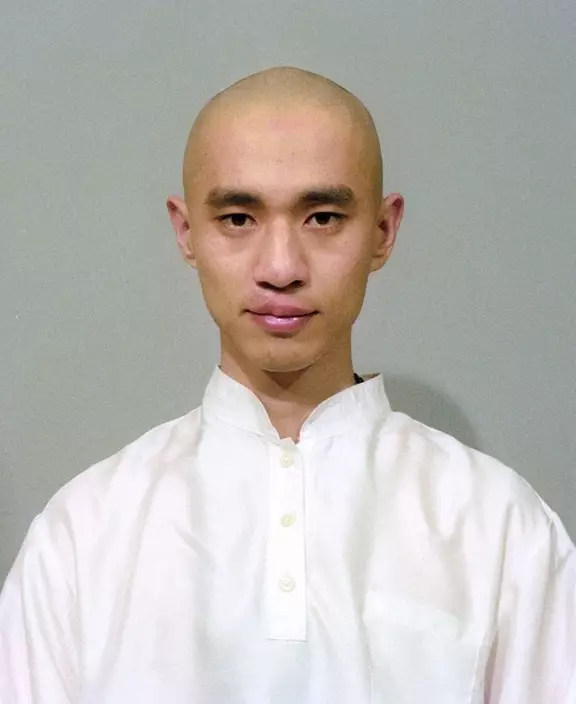
The Jan. 7, 1990 photo shows Tomomitsu Niimi, a member of Aum Shinrikyo doomsday cult who has been sentenced to death. Tuesday, March 20, 2018 marks 23 years since members of the Aum Shinrikyo cult punctured plastic bags to release sarin nerve gas inside subway cars, sickening thousands and killing 13. Cult leader Shoko Asahara and a dozen followers have been sentenced to death for that and other crimes that killed 27 in all. (Kyodo News via AP)
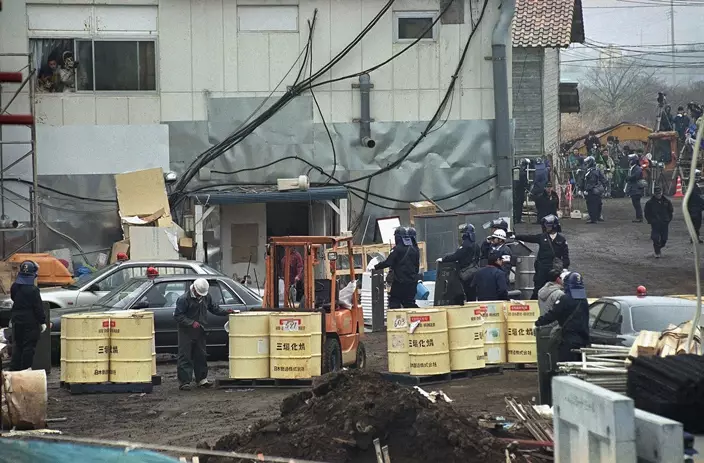
FILE - In this March 25, 1995, file photo, Aum Shinrikyo members look out from a window to observe the fourth-day of a police raid operation at No. 6 Satian, one of the doomsday cult's communes near Mount Fuji in Kamikuishiki, west of Tokyo. (AP Photo/Hiroshi Otabe, File)

FILE - This 1990 file photo shows former member of Aum Shinrikyo doomsday cult Kazuaki Okazaki who has been sentenced to death. Tuesday, March 20, 2018 marks 23 years since members of the Aum Shinrikyo cult punctured plastic bags to release sarin nerve gas inside subway cars, sickening thousands and killing 13. (Kyodo News via AP, File)
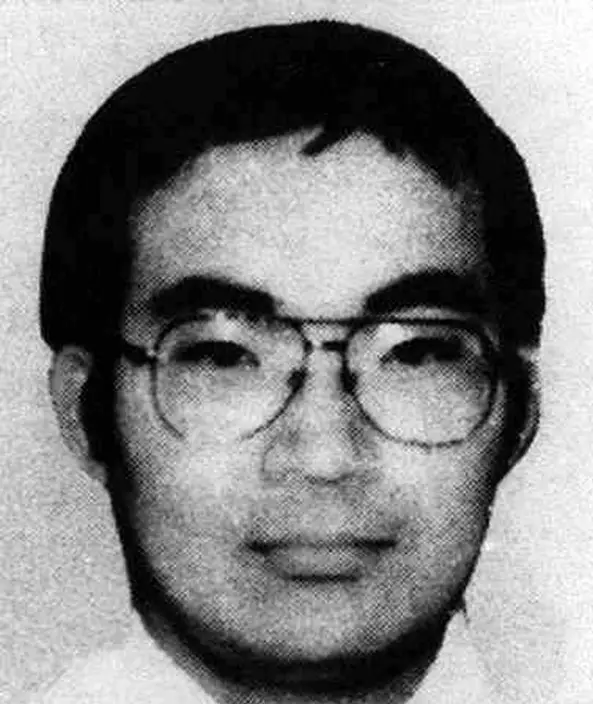
FILE - This undated file photo shows A former Aum Shinrikyo cult member Masato Yokoyama who was sentenced to death in 1999. Thirteen Japanese cult members may be sent to the gallows any day now for a deadly 1995 gas attack on the Tokyo subway system and other crimes. (AP Photo/Kyodo News)
The relocation of seven of them to five detention centers outside of Tokyo last week has sparked speculation that executions could be imminent. In Japan, accomplices in a crime are customarily hanged on the same day. Ten of those on death row were convicted for the subway attack, a number beyond the Tokyo detention center's daily capacity.
As with all executions in Japan, when and where they will be killed isn't being released, even to family members and lawyers. The executions won't be announced until they have already happened.
Takahashi recently asked the Justice Ministry for a chance to meet the convicts and witness their executions. "I want to follow through to the very end," Takahashi said at a recent news conference.
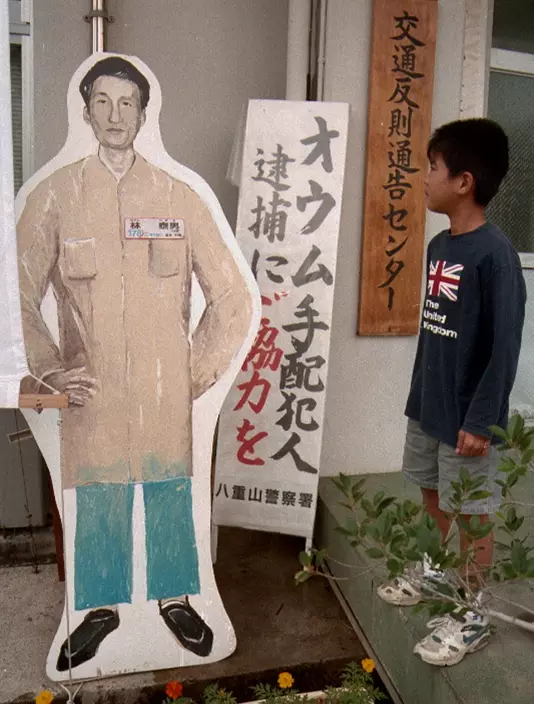
The Dec. 3, 1996 photo shows a cutout of Yasuo Hayashi, a member of Aum Shinrikyo doomsday cult who has been sentenced to death, near a local police station in Okinawa. (Kyodo News via AP)
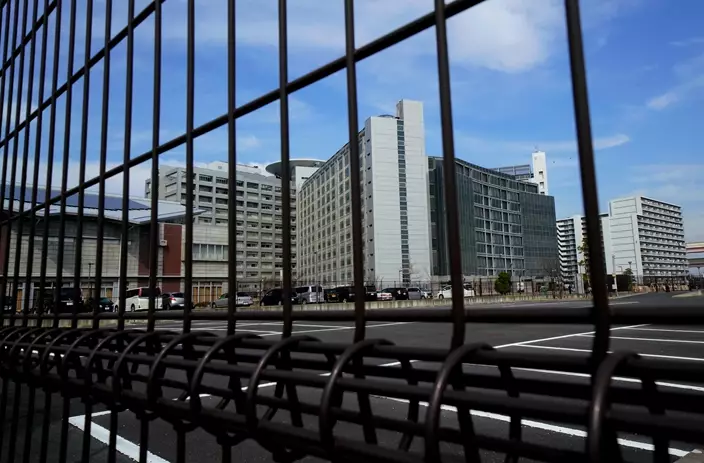
This March 15, 2018 photo, shows the Tokyo Detention Center in Tokyo. Thirteen Japanese cult members may be sent to the gallows any day now for a deadly 1995 gas attack on the Tokyo subway system and other crimes. (AP Photo/Shizuo Kambayashi)

In this March 15, 2018 photo, people walk near the Tokyo Detention Center in Tokyo. Thirteen Japanese cult members may be sent to the gallows any day now for a deadly 1995 gas attack on the Tokyo subway system and other crimes. (AP Photo/Shizuo Kambayashi)
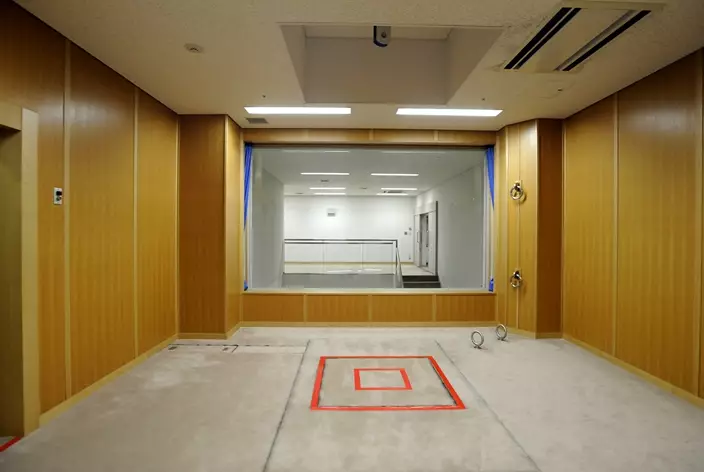
FILE - This Aug. 27, 2010 file shows the main gallows of the Tokyo Detention Center in Tokyo. Thirteen Japanese cult members may be sent to the gallows any day now for a deadly 1995 gas attack on the Tokyo subway system and other crimes. (Kyodo News via AP, File)
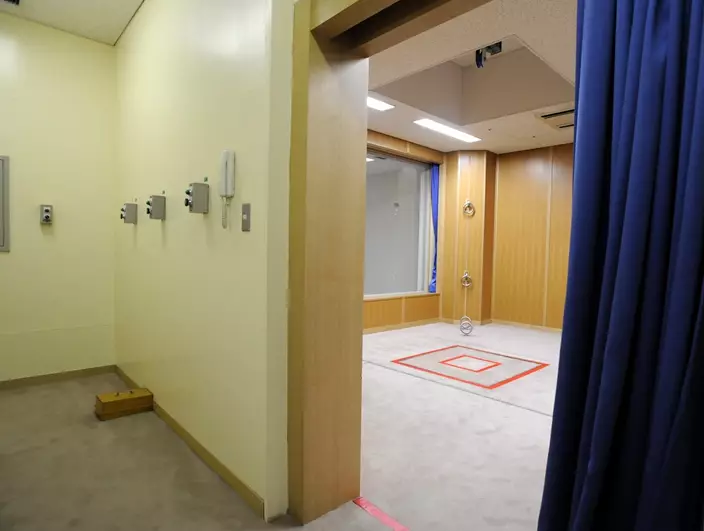
FILE - In this Aug. 27, 2010, file photo, multiple push buttons for executioners to activate a trapdoor are seen on the wall of a room adjacent to the main execution chamber with a ceiling-mounted pulley and the trapdoor marked with red squares on the floor at the Tokyo Detention Center in Tokyo. (Kyodo News via AP, File)
Her wish is unlikely to be granted.
Even prisoners sent to the gallows are not notified until guards come to their cells in the morning. After a chat with a chaplain, a last bite or smoke, the prisoner is taken to the gallows.
If all 10 subway attack convicts are hanged, it would be the second-largest number executed on a single day in Japan's modern history. Japan on Jan. 24, 1911, hanged 11 political prisoners who allegedly plotted to assassinate the emperor.

The Jan. 7, 1990 photo shows Tomomasa Nakagawa, a member of Aum Shinrikyo doomsday cult who has been sentenced to death. Tuesday, March 20, 2018 marks 23 years since members of the Aum Shinrikyo cult punctured plastic bags to release sarin nerve gas inside subway cars, sickening thousands and killing 13. (Kyodo News via AP)

Subway staff members offer a silent prayer at a station in Tokyo Tuesday, March 20, 2018, to mark the 23rd anniversary of sarin nerve gas attack by the Aum Shinrikyo cult. Members of the Aum Shinrikyo cult punctured plastic bags to release sarin nerve gas inside subway cars in 1995, sickening thousands and killing 13. (Yoshitaka Sugawara/Kyodo News via AP)
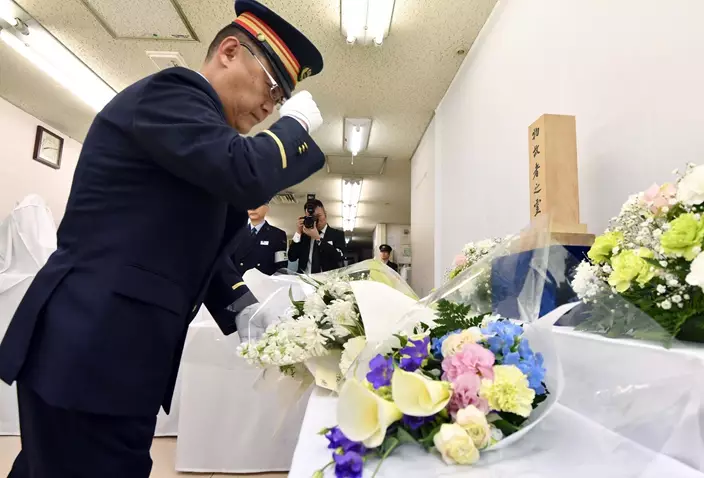
Toyohiko Otomo, head of the Kasumigaseki subway station district, offers flowers at Kasumigaseki station in Tokyo Tuesday, March 20, 2018, to mark the 23rd anniversary of sarin nerve gas attack by the Aum Shinrikyo cult. Members of the Aum Shinrikyo cult punctured plastic bags to release sarin nerve gas inside subway cars in 1995, sickening thousands and killing 13. (Yoshitaka Sugawara/Kyodo News via AP)
Some survivors of the cult's crimes oppose the executions because that would eliminate hopes for a fuller explanation of the crimes.
Asahara talked incoherently, occasionally babbling in broken English, during his eight-year trial and never acknowledged his responsibility or offered meaningful explanations.
Born Chizuo Matsumoto, he has been on death row for nearly 14 years. His family says he is a broken man, constantly wetting and soiling the floor in his cell and not communicating with his family or lawyers.
His 34-year-old daughter, Rika Matsumoto, said he doesn't understand his punishment and needs treatment so he can recover and talk. "I just want to hear my father explain in his own words," she tweeted recently.
Some of the condemned have expressed regret and contributed to anti-terrorism measures. Shoko Egawa, a journalist who has covered the cult's crimes from early on, has proposed keeping them alive so they can provide lessons to a world facing the growing threat of extremism.
Experts on the cult also warn that if they are executed, the members would be glorified as martyrs by cult remnants, likely bolstering their worship of Asahara.
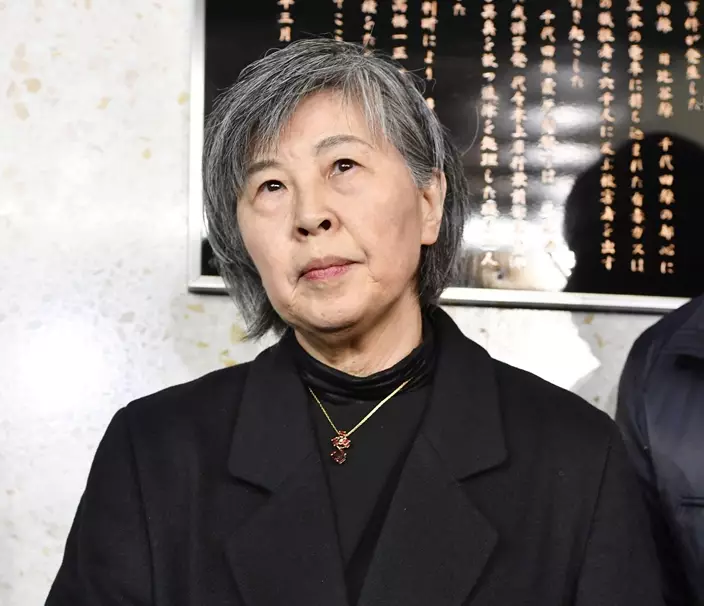
Shizue Takahashi, the wife of a subway worker killed in the March 20, 1995 sarin gas attack, speaks to journalists in Tokyo Tuesday, March 20, 2018, on the occasion of the 23rd anniversary of sarin nerve gas attack by the Aum Shinrikyo cult. Members of the Aum Shinrikyo cult punctured plastic bags to release sarin nerve gas inside subway cars in 1995, sickening thousands and killing 13. (Yoshitaka Sugawara/Kyodo News via AP)
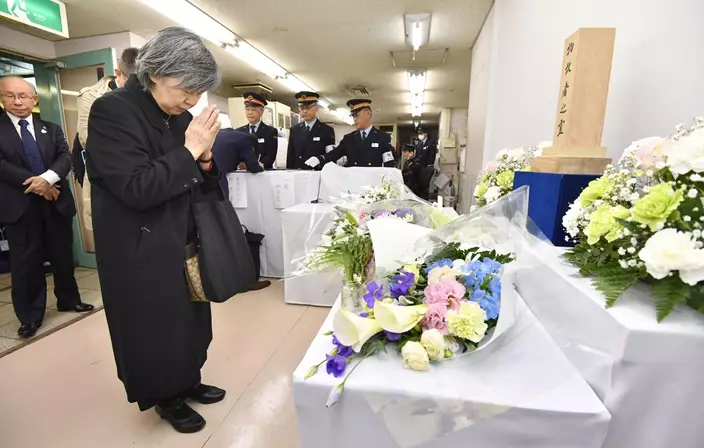
Shizue Takahashi, the wife of a subway worker killed in the March 20, 1995 sarin gas attack, prays after laying flowers on the stand set up at Kasumigaseki subway station in Tokyo Tuesday, March 20, 2018, to mark the 23rd anniversary of sarin nerve gas attack by the Aum Shinrikyo cult. (Yoshitaka Sugawara/Kyodo News via AP)
Founded in 1984, the group attracted many young people, even graduates of top universities, whom Asahara hand-picked as close aides.
The cult amassed an arsenal of chemical, biological and conventional weapons to carry out Asahara's escalating criminal orders in anticipation of an apocalyptic showdown with the government.
The cult claimed 10,000 members in Japan and 30,000 in Russia. It has disbanded, though nearly 2,000 people follow its rituals in three splinter groups, monitored by authorities.
GENEVA (AP) — The World Anti-Doping Agency said after reviewing various media reports that it stands by its decision to clear 23 Chinese swimmers who tested positive for a banned heart medication before the 2021 Tokyo Olympics.
WADA addressed questions at a news conference on Monday and acknowledged there would be skepticism about details of the case after the release on Sunday of a documentary by German broadcaster ARD.
In an earlier statement following initial newspaper reports led by the New York Times, WADA said it agreed with Chinese authorities and ruled the swimmers’ samples were contaminated.
The contamination was accepted to have come from spice containers in the kitchen of a hotel where some of the Chinese team stayed for a national meet in January 2021
Chinese authorities handling the case after testing the swimmers in January 2021 cleared them without any penalties and WADA accepted their conclusions. Sending independent investigators to China that year was not feasible during the COVID-19 pandemic.
“We had no credible way to disprove the contamination theory," WADA prosecutor Ross Wenzel told reporters in an online call on Monday, adding there was no political pressure to drop the case.
Wenzel detailed a timeline from January to June 2021 for the case to be resolved. That was just weeks before the Tokyo Olympics opened, and with the Beijing Winter Games approaching in February 2022 that was a personal project for Chinese President Xi Jinping.
Chinese swimmers went on to win three gold medals in Tokyo, where the United States took silver in two of those races and Britain was second in the other.
“Following WADA’s review of the documentary, the agency still stands firmly by the results of its scientific investigation and legal decision concerning the case,” WADA said in the statement before putting forward its senior managers up for questioning on Monday
WADA said based on available scientific evidence and intelligence, “which was gathered, assessed and tested by experts in the pharmacology of trimetazidine (TMZ); and, by anti-doping experts,” it had no basis under the global anti-doping code to challenge the Chinese agency's findings of environmental contamination.
The drug at the center of this case was also the medication that led to the suspension of Russian figure skater Kamila Valieva at the Winter Olympics in Beijing in 2022.
In that case, WADA moved to appeal and sought sanctions for Valieva after Russian anti-doping authorities judged she was not to blame.
China's star swimmer Sun Yang also tested positive for TMZ and served a three-month ban in 2014. That case also was kept quiet by Chinese and swim authorities and provoked criticism from opponents when he won at the world championships the next year. Sun was later banned for breaking doping rules in a high-profile case WADA did pursue.
Dismissing weekend suggestions WADA was “soft on Chinese athletes,” agency president Witold Bańka reminded reporters it had been “vigorously pursuing justice” in the Sun case. A ban of more than four years for three-time Olympic champion Sun expires next month.
WADA said its position in the latest Chinese case was also accepted by World Aquatics, which governs international swimming.
Chinese Foreign Ministry spokesperson Wang Wenbin on Monday described the media reports as “disinformation and a misrepresentation,” and affirmed WADA’s decision.
Wang said China’s anti-doping authorities investigated the incident and found the positive results were due to “the ingestion of contaminated food by the relevant athletes without knowledge of the contaminated food, and the Chinese swimmers involved were not at fault or negligent, which did not constitute a doping violation."
However, anti-doping rules in Olympic sports do require a provisional suspension — which the Chinese swimmers avoided from their national anti-doping agency — when athletes test positive for TMZ, except if contamination is suspected.
“I want to emphasize,” Wang said, “that the Chinese government has maintained a firm stance of zero tolerance towards doping, strictly abides by the WADA code, resolutely safeguards the physical and mental health of athletes, maintains fair play in sports competitions, and contributes positively to the global efforts in the crackdown on doping.”
China has given almost $2 million to WADA in recent years above its expected payments as a national government.
The 30-member Chinese swim team won six medals in Tokyo, including three golds. Zhang Yufei won the women's 200 meters butterfly ahead of Regan Smith of the United States, and silver in the 100 butterfly where American Torri Huske was out of the medals in fourth.
Zhang and Yang Junxuan were part of the 4x200 freestyle relay team that took gold, edging the Americans including seven-time Olympic champion Katie Ledecky. Canada was fourth.
“Doping can deprive clean athletes of hard-earned moments they deserve such as standing on the podium and the life-changing opportunities that may follow,” Swimming Canada said Sunday in a statement.
In the men's 200 medley in Tokyo, Wang Shun beat silver medalist Duncan Scott, the British star who refused to share a medal podium with Sun Yang at the 2019 world championships.
Many of the athletes still compete for China and are expected to swim at the Paris Olympics that start in July.
WADA said it was given a tip by the U.S. Anti-Doping Agency as early as 2020 — before this case arose — about allegations of doping cover-ups in China but the USADA never followed up with evidence.
USADA CEO Travis Tygart called the news of the Chinese positive tests “crushing.”
“It’s even more devastating to learn the World Anti-Doping Agency and the Chinese Anti-Doping Agency secretly, until now, swept these positives under the carpet by failing to fairly and evenly follow the global rules that apply to everyone else in the world,” Tygart said.
The case underscores what many view as a flaw in the global anti-doping system — that a country's own anti-doping organization is often the first line of defense in catching drug cheats and those organizations have different levels of motivation to fulfil that role.
AP sports: https://apnews.com/sports
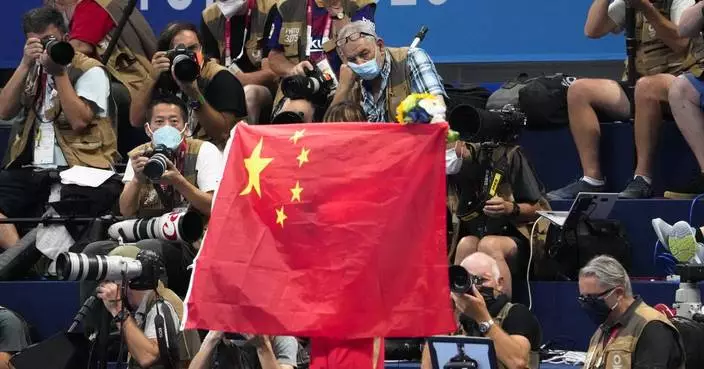
WADA stands by decision to clear Chinese swimmers for Tokyo Olympics citing contaminated samples

WADA stands by decision to clear Chinese swimmers for Tokyo Olympics citing contaminated samples

FILE - A Chinese flag is unfurled on the podium of a swimming event final at the 2020 Summer Olympics, on July 29, 2021, in Tokyo, Japan. An Australian newspaper said Saturday, April 20, 2024, 23 Chinese swimmers were cleared to compete at the Tokyo Olympics despite testing positive to doping because world governing bodies agreed with Chinese authorities and ruled that the tests had been contaminated.(AP Photo/Charlie Riedel, File)

























